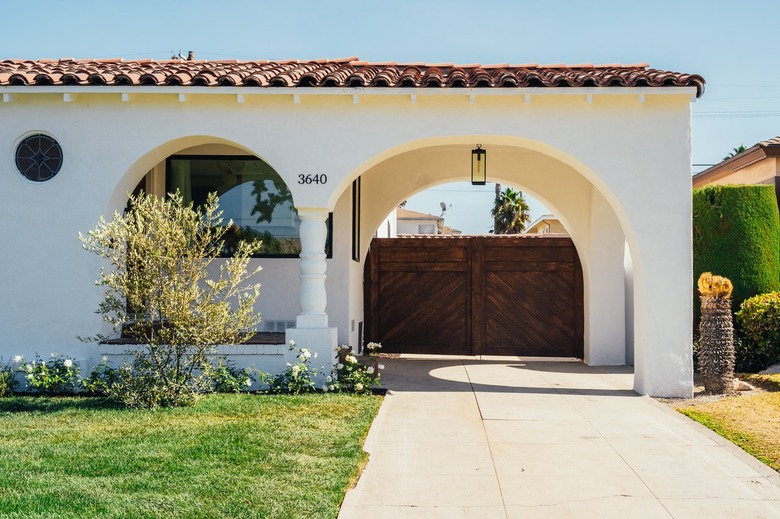How To Get Black Algae Off A Concrete Driveway
We may receive a commission on purchases made from links.
When you see black spots on a concrete driveway, it could be mold, but it's just as likely to be algae. They aren't the same thing, but they're close. Mold is a type of fungus, while algae is a form of plant life. For the purposes of cleaning them off your driveway, the differences aren't great enough to matter.
Fungi propagate by spores and so do many species of algae, including Gloeocapsa magma, the one that is most likely to be causing the black spots on your driveway. When the microscopic spores land on a suitable surface, such as your driveway, they send out roots that feed on tar, limestone, and gravel, and they grow into a colony that can support other organisms, including mold. Black algae isn't a health hazard, but some of the mold growth it supports may be, and in any case, algae are slippery and unsightly and should be removed.
A Pressure Washer Is the Best Concrete Stain Remover
A Pressure Washer Is the Best Concrete Stain Remover
The best way to remove mold, moss, and algae is to kill the roots or uproot the colony, and while scrubbing with soap and water is the safest, most reliable method, a power washer is faster. Black algae also grows on siding and roofs where pressure washing isn't recommended because of the damage it can do to shingles and lapped siding. Pressure washing is generally safe for driveways, but it can disfigure concrete if you don't do it correctly.
The wrong way to pressure wash a driveway would be to turn up the pressure to more than 2,500 psi, use a tip with a very narrow aperture, and hold the tip very close to the surface. That will definitely uproot the algae, but it will leave streaks and could possibly chip or gouge the concrete. Instead, it's better to use the power washer at a lower pressure in conjunction with a mold and mildew cleaner for concrete.
Removing Black Algae With a Pressure Washer
Removing Black Algae With a Pressure Washer
To safely remove mold from your driveway, use a pressure of 2,500 psi or less, which is a pressure many electric models can provide. You want a nozzle that disperses the spray sufficiently to prevent damage but not widely enough to completely lose the effects of the pressure. Pressure washer nozzles are color-coded, and the best ones for driveway cleaning are the yellow (15 degrees) and green (25 degrees) ones.
Before doing the actual pressure washing, it's a good idea to soak the algae with a detergent to loosen its grip and make it easier to wash away. Use a standard mold-killing detergent made for pressure washers that doesn't contain bleach, which will corrode the washer pump and is bad for the environment. Apply it with the pressure washer using a black nozzle (65 degrees) and let it soak in for an hour or so before you blast away at full pressure with the green or yellow nozzle. Always keep the nozzle at least 6 inches from the surface to prevent streaking.
Use an Algae-Killing Detergent as an Alternative
Use an Algae-Killing Detergent as an Alternative
You don't have to use a pressure washer to get rid of black algae, and sometimes, it isn't the best way to go — for instance, if the algae has spread to the concrete inside the garage. An alternative is to use a cleaner specifically designed to kill algae, such as Wet & Forget. Products such as this often come in containers with a convenient hose attachment, allowing you to apply them with a garden hose.
Apply the product when the temperature is between 32 and 80 degrees Fahrenheit. The product needs time to soak in before it evaporates, so the cooler the temperature when you apply it, the better. It takes from one to two months for such a product to work, so be patient. Once the algae dies and washes away in the rain, you can prevent a recurrence with occasional repeated treatments.
